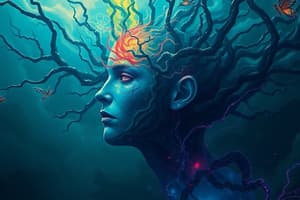Podcast
Questions and Answers
La schizophrénie est considérée comme une maladie rare touchant seulement 0,1% de la population.
La schizophrénie est considérée comme une maladie rare touchant seulement 0,1% de la population.
False (B)
Le terme 'schizophrénie' signifie étymologiquement 'esprit scindé'.
Le terme 'schizophrénie' signifie étymologiquement 'esprit scindé'.
True (A)
La prévalence de la schizophrénie est plus élevée chez les femmes que chez les hommes.
La prévalence de la schizophrénie est plus élevée chez les femmes que chez les hommes.
False (B)
Chlorpromazine a été le premier neuroleptique introduit pour traiter les psychoses en 1952.
Chlorpromazine a été le premier neuroleptique introduit pour traiter les psychoses en 1952.
Les symptômes dépressifs ne sont jamais présents chez les personnes atteintes de schizophrénie.
Les symptômes dépressifs ne sont jamais présents chez les personnes atteintes de schizophrénie.
La schizophrénie peut apparaître exceptionnellement pendant l'enfance.
La schizophrénie peut apparaître exceptionnellement pendant l'enfance.
Les symptômes négatifs incluent le délire et les hallucinations.
Les symptômes négatifs incluent le délire et les hallucinations.
Les déficits cognitifs dans la schizophrénie affectent d'abord la mémoire à long terme.
Les déficits cognitifs dans la schizophrénie affectent d'abord la mémoire à long terme.
La désorganisation de la pensée est classée exclusivement comme un symptôme positif.
La désorganisation de la pensée est classée exclusivement comme un symptôme positif.
Un syndrome délirant paranoïde est une composante courante de la sémiologie schizophrénique.
Un syndrome délirant paranoïde est une composante courante de la sémiologie schizophrénique.
Le diagnostic positif repose uniquement sur une évaluation psychologique standardisée.
Le diagnostic positif repose uniquement sur une évaluation psychologique standardisée.
La schizophrénie a principalement une origine génétique, sans autres facteurs contribuant à son apparition.
La schizophrénie a principalement une origine génétique, sans autres facteurs contribuant à son apparition.
Pour satisfaire le critère A du DSM IV, il faut vérifier la présence d'au moins deux symptômes prédéfinis pendant au moins 1 mois.
Pour satisfaire le critère A du DSM IV, il faut vérifier la présence d'au moins deux symptômes prédéfinis pendant au moins 1 mois.
Le taux de mortalité par suicide parmi les patients évalués est estimé à 5%.
Le taux de mortalité par suicide parmi les patients évalués est estimé à 5%.
La phase d'état de la schizophrénie peut se caractériser par un retrait social actif.
La phase d'état de la schizophrénie peut se caractériser par un retrait social actif.
Un pourcentage significatif, entre 20 et 25%, des patients ne présenteront plus de signe patent de la maladie.
Un pourcentage significatif, entre 20 et 25%, des patients ne présenteront plus de signe patent de la maladie.
Les symptômes négatifs incluent également des comportements désorganisés.
Les symptômes négatifs incluent également des comportements désorganisés.
Le critère B du diagnostic concerne le fonctionnement social du patient.
Le critère B du diagnostic concerne le fonctionnement social du patient.
Les patients présentant une forme intermédiaire de la maladie éprouvent des accès récurrents ou une symptomatologie intense.
Les patients présentant une forme intermédiaire de la maladie éprouvent des accès récurrents ou une symptomatologie intense.
Aucune affection médicale générale ne peut être présente pour établir le diagnostic selon le critère E.
Aucune affection médicale générale ne peut être présente pour établir le diagnostic selon le critère E.
20-25% des personnes atteintes de schizophrénie présentent une forme grave nécessitant une hospitalisation prolongée.
20-25% des personnes atteintes de schizophrénie présentent une forme grave nécessitant une hospitalisation prolongée.
Les interventions psychosociales n'ont aucun impact sur l'amélioration clinique de la schizophrénie.
Les interventions psychosociales n'ont aucun impact sur l'amélioration clinique de la schizophrénie.
Le traitement des schizoïdes se concentre uniquement sur des médicaments antipsychotiques.
Le traitement des schizoïdes se concentre uniquement sur des médicaments antipsychotiques.
La prise en charge de la schizophrénie est exclusivement biologique et ne nécessite aucune approche psychosociale.
La prise en charge de la schizophrénie est exclusivement biologique et ne nécessite aucune approche psychosociale.
Les médicaments tels que les benzodiazépines sont utilisés dans le traitement biologique de la schizophrénie.
Les médicaments tels que les benzodiazépines sont utilisés dans le traitement biologique de la schizophrénie.
La stimulation magnétique transcrânienne est considérée comme un traitement non médicamenteux pour la schizophrénie.
La stimulation magnétique transcrânienne est considérée comme un traitement non médicamenteux pour la schizophrénie.
L'électroconvulsivothérapie (ECT) est une méthode de traitement considérée comme archaïque et inefficace.
L'électroconvulsivothérapie (ECT) est une méthode de traitement considérée comme archaïque et inefficace.
Le risque suicidaire ou homicidaire nécessite une hospitalisation avec surveillance permanente.
Le risque suicidaire ou homicidaire nécessite une hospitalisation avec surveillance permanente.
L'approche biopsychosociale ne prend pas en compte la réinsertion sociale des patients schizophrènes.
L'approche biopsychosociale ne prend pas en compte la réinsertion sociale des patients schizophrènes.
Les thérapies cognitives et comportementales sont exclues du traitement de la schizophrénie.
Les thérapies cognitives et comportementales sont exclues du traitement de la schizophrénie.
Flashcards
Schizophrénie Définition
Schizophrénie Définition
Troubles mentaux fréquents, sévères et hétérogènes ; Ils évoluent sur le long terme et sont invalidants.
Épidémiologie (Schizophrénie)
Épidémiologie (Schizophrénie)
1 % de la population est touchée. Habituellement entre 15 et 30 ans. Incidence similaire entre hommes et femmes.
Début de la Schizophrénie
Début de la Schizophrénie
Le début de la schizophrénie se manifeste souvent en différentes phases.
Syndrome dissociatif Définition
Syndrome dissociatif Définition
Signup and view all the flashcards
Syndrome délirant
Syndrome délirant
Signup and view all the flashcards
Déficits cognitifs (Schizophrénie)
Déficits cognitifs (Schizophrénie)
Signup and view all the flashcards
Perturbations de l'humeur
Perturbations de l'humeur
Signup and view all the flashcards
Chlorpromazine
Chlorpromazine
Signup and view all the flashcards
Démence précoce
Démence précoce
Signup and view all the flashcards
Schizophrénie (Etymologie)
Schizophrénie (Etymologie)
Signup and view all the flashcards
Symptômes négatifs de la schizophrénie
Symptômes négatifs de la schizophrénie
Signup and view all the flashcards
Symptômes positifs de la schizophrénie
Symptômes positifs de la schizophrénie
Signup and view all the flashcards
Idées délirantes (schizophrénie)
Idées délirantes (schizophrénie)
Signup and view all the flashcards
Hallucinations (schizophrénie)
Hallucinations (schizophrénie)
Signup and view all the flashcards
Discours désorganisé (schizophrénie)
Discours désorganisé (schizophrénie)
Signup and view all the flashcards
Diagnostic positif (schizophrénie)
Diagnostic positif (schizophrénie)
Signup and view all the flashcards
Taux de mortalité élevé (schizophrénie)
Taux de mortalité élevé (schizophrénie)
Signup and view all the flashcards
Insertion socio-professionnelle (schizophrénie)
Insertion socio-professionnelle (schizophrénie)
Signup and view all the flashcards
Evolution intermédiaire (schizophrénie)
Evolution intermédiaire (schizophrénie)
Signup and view all the flashcards
DSM-IV
DSM-IV
Signup and view all the flashcards
Traitement de la schizophrénie
Traitement de la schizophrénie
Signup and view all the flashcards
Médicaments antipsychotiques
Médicaments antipsychotiques
Signup and view all the flashcards
Psychothérapie
Psychothérapie
Signup and view all the flashcards
Réadaptation sociale
Réadaptation sociale
Signup and view all the flashcards
Hospitalisation pour schizophrénie
Hospitalisation pour schizophrénie
Signup and view all the flashcards
Électroconvulsivothérapie (ECT)
Électroconvulsivothérapie (ECT)
Signup and view all the flashcards
Stimulation magnétique transcrânienne
Stimulation magnétique transcrânienne
Signup and view all the flashcards
Thérapies cognitives et comportementales (TCC)
Thérapies cognitives et comportementales (TCC)
Signup and view all the flashcards
Psychoéducation
Psychoéducation
Signup and view all the flashcards
Causes de la schizophrénie
Causes de la schizophrénie
Signup and view all the flashcards
Study Notes
Introduction to Schizophrenia
- Schizophrenia is a common, severe, heterogeneous, long-term, and disabling mental illness.
- Symptoms vary between patients.
- Multiple etiological factors exist, but no single definitive cause is known.
Historical Context
- The term "psychosis" was coined by Ernst von Feuchtersleben in 1847 to describe acute forms of madness.
- B. A. Morel used "dementia praecox" in 1860 to characterize deteriorating mental illnesses beginning in adolescence.
- Eugen Bleuler introduced the term "schizophrenia" in 1911, referring to a split mind, meaning an impairment of relations between thoughts, emotions, and actions.
- Chlorpromazine, the first neuroleptic, was introduced in 1952 for treating psychoses.
Epidemiology
- Schizophrenia affects approximately 1% of the population.
- Typically onset between ages 15 and 30.
- Rare cases may occur in childhood or after age 30.
- Lifetime prevalence is 1.3%.
- Male and female occurrences show roughly similar rates initially. However, males tend to experience earlier onset and more severe forms.
Clinical Aspects
- Schizophrenia's onset is often diverse and misleading.
- Active social withdrawal (isolation, lack of initiative leading to neglect), and a detached demeanor are common symptoms.
- Delusions (fixed false beliefs) and hallucinations (sensory experiences without external stimuli) are possible symptoms.
- Cognitive deficits include difficulties in concentration, attention maintenance, and short-term memory impacting daily tasks and learning.
- Mood disturbances, such as depression or anxiety, frequently accompany schizophrenia.
Symptoms: Positive and Negative
- Negative symptoms represent a reduction or loss of normal functions, such as flat affect, social withdrawal, and loss of motivation.
- Positive symptoms indicate an increase in activity or response, including delusions, hallucinations, and disorganized thinking.
Diagnosis
- Diagnosis hinges on a detailed psychiatric interview and assessment.
- DSM-IV criteria for schizophrenia include a minimum of two significant symptoms present for a month, social dysfunction, lasting six months, and an exclusion of mood disorder and other medical conditions.
Evolution and Prognosis
- High suicide risk (10% mortality rate) exists.
- 20-25% of patients may develop a normal life trajectory.
- 50% have moderate symptoms and recurring episodes, impacting their social, familial, and work life.
- 20-25% experience severe, persistent, symptoms and require extended hospitalization.
Management
- Treatment primarily centers on antipsychotic medications.
- Psychotherapy, including cognitive behavioral therapy, is crucial.
- Social support and rehabilitation services are essential for recovery.
Hospitalization
- Patients requiring hospitalization are individuals with risks of suicide or homicide and need constant supervision and removal of potential harm.
Biological Treatments
- Neuroleptics are a primary biological treatment.
- Benzodiazepines might also be used.
Non-medication Treatments
- Electroconvulsive therapy (ECT)
- Transcranial magnetic stimulation (TMS)
- Cognitive-behavioral therapy (CBT)
- Psychoeducational interventions are also used.
Rehabilitation and Social Reintegration
- Schizophrenia management necessitates a biopsychosocial approach, integrating medical treatment, psychosocial support, and rehabilitation efforts.
- The illness has highly diverse clinical presentations.
- Early intervention and comprehensive management are critical.
Studying That Suits You
Use AI to generate personalized quizzes and flashcards to suit your learning preferences.



